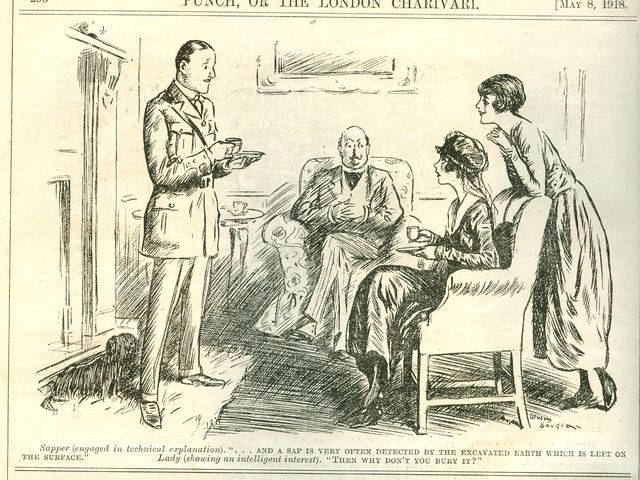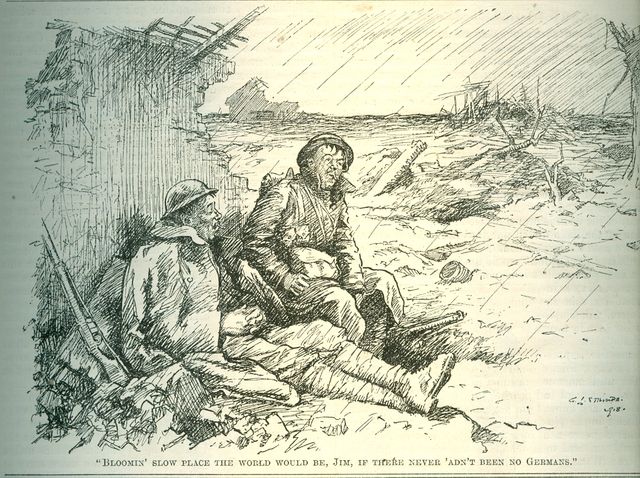http://i60.photobucket.com/albums/h8/S22904945/strenuous_zpsnre9qm0v.jpg
1918: Nice Change
She manages to find a good reason for indulging in her selfish behaviour. I think we all know people who tend to behave like that.
http://i60.photobucket.com/albums/h8/S22904945/strenuous_zpsnre9qm0v.jpg
1918: Nice Change
She manages to find a good reason for indulging in her selfish behaviour. I think we all know people who tend to behave like that.

1918: Intelligent Interest?
In 1918 the word ‘sap’ was sometimes used with a meaning that is now obsolete. In that meaning it was simply a trench. In Eighteenth Century warfare saps were used by besieging armies. During World War One the word trench was more often used but here the army officer is still using the earlier word. The woman’s well-meant question was wrong because if you buried the earth you removed the sap.
The earlier saps had been the responsibility of the Royal Engineers. They were, and no doubt still are, informally called the Sappers. In the Royal Engineers privates are called Sappers just as in the Artillery they called Gunners.
During my army days I was aware of a kind of unofficial pecking order for the various army formations. Top of the list were the actual fighting regiments such as the infantry and the artillery. There followed various support corps such as the Service Corps, the Ordnance Corps and the Signals Corps. I gather it is rather different now with things like the Logistics Corps. There was also a kind of pecking order within that list. I am firmly of the opinion that the Sappers came top of among the support formations. My own corps, the Educational Corps came way down the list but still ahead, in my opinion, of the Catering Corps and Pioneer Corps in which my father served for a time during World War Two.
http://i60.photobucket.com/albums/h8/S22904945/push-bike_zpssqf302ne.jpg
1918: Hard-up Artist
War or no war for an artist being broke is a frequently experienced condition.
I will say again Magoo , these little snapshots are just wonderful, please hope you don"t run out of them.
smile.
You must work so hard to dig them all out . Respect.
smile.
http://i60.photobucket.com/albums/h8/S22904945/somethink_zpsdpig2zhb.jpg
1918: Finding solace
I think that ‘Arry is just clutching at straws. Just being reminded of the froth on a glass of beer isn’t much comfort.
http://i60.photobucket.com/albums/h8/S22904945/wireless_zpsi2sl7xz0.jpg
1918: Ask a silly question
This joke is presented as a typical ‘put down’ by the soldier whose right hand was severely damaged. He would probably never be able to use it normally again. The question was genuine but he had no intention of telling her the truth. It may well have suffered during hand to hand fighting in no man’s land.
It tells us a more important truth. The men who had actively fought during the war tended never to discuss the details of their daily lives. Some, very much later, did talk when sympathetically questioned. Most, however, went to their graves without ever revealing the reality of trench warfare.
http://i60.photobucket.com/albums/h8/S22904945/photo_zpsqagylgnq.jpg
1918: Force of habit
Taking a photograph was a much lengthier affair 100 years ago. You had to sit still for quite a while for the image to build up. The sound of the camera clicking must have seemed like a hostile shot.
http://i60.photobucket.com/albums/h8/S22904945/bolshevism_zpsypr0t8tn.jpg
1918: Bolshevism
After the October Revolution of 1917 the Bolsheviks (aka Communists) had taken control of Russia. This caused consternation in aristocratic families such as the one depicted here.
Is this a joke about a silly woman who has heard the name bolshevism bandied about and thought people were discussing an actual physical ailment? Is it instead about fearing that her daughter might actually be influenced by communist ideology? We can’t be certain but my guess is that first suggestion is the correct one.
I think that the child is probably suffering from what used to be called ‘growing pains’.
http://i60.photobucket.com/albums/h8/S22904945/margarine_zps4yvp4uyr.jpg
1918: Old saying brought up to date
Replacing butter with margarine was seen as a major privation by this stage in World War One. The artist has found a round-about way of mentioning this.

1918: The only story in town
For the soldiers in this cartoon the war is the only thing that is happening. For the civilians reading Punch this also has come to be the case.
http://i60.photobucket.com/albums/h8/S22904945/solrsact_zpsjn2u3lsx.jpg
1918: Theatrical Soldiers
What is going on here? Why are these reluctant thespians who under military orders being told to perform in this play? The explanation goes like this.
It is probably not well known that troops did not man the trenches on a permanent basis apart from occasional leave. In fact whole units would be withdrawn from time to time and replaced by fresh troops to take their place. The changeover was achieved under cover of darkness. The new unit would occupy all the positions previously held by the predecessors. In the morning at first light the enemy would not be aware of any change in their opposite trenches.
The men would now be transferred to a camp behind the lines. Here tired bodies and frayed nerves would begin to heal. The men were able to enjoy a good night sleep in clean beds, proper washing facilities and regular cooked meals. This was not arranged as an act of benevolence. Without these occasional rest periods even the best soldiers could not be expected to be as fit and alert as was necessary. Then, refreshed and invigorated they could get back to the serious business of defeating the ‘Hun’.
Some leisure activities were also needed to prevent the men from getting bored. Sport was the obvious answer. But this could not occupy the entire time and the weather was not always suitable. This is where the amateur theatricals came in though one does wonder whether a more suitable play could have been chosen in this instance.
By the way from reading autobiographies written well after WW1 we learn that a few soldiers at the time were not at all reluctant to kiss (and more than kiss) each other. When they did so they had to be very careful not to be seen doing so. The penalties were severe.
http://i60.photobucket.com/albums/h8/S22904945/mysogony_zpsfafipuqz.jpg
1918: Not happily married
The joke has nothing to do with the war. Nevertheless it is told in a military setting. The war did seem to be involved in just about everything.
http://i60.photobucket.com/albums/h8/S22904945/egg_zpsn5qe0mpa.jpg
1918: The war and the servant problem
Before, during and after World War 1 the servant problem was never far from the minds of the readers of Punch. During WW1 the problem could well be the absence of servants. More lucrative jobs were available that tempted many away from their employers.
This cartoon shows the son of the house bravely attempting to support his mother in her more important role that she is playing. I would guess that her job is as an unpaid organiser of some committee that is supporting the country in its hour of need.
To us the boy looks altogether too feminine but I assume that the artist was accurately describing an upper middle class boy at the time.
http://i60.photobucket.com/albums/h8/S22904945/sand_zpsje6ec4dm.jpg
1918: One more problem is solved
The ‘special’ is a part-time policeman. His response to a truly asinine question is one of gentle sarcasm. Sandbags were used to protect public buildings in case of enemy air raids. I can remember them similarly used during World War Two.
http://i60.photobucket.com/albums/h8/S22904945/hat_zpstw0pikab.jpg
1918: Mistaken for a hat
In order to make this joke ‘work’ the artist has deliberately ignored an important convention about ladies hats. This convention demands that women put on a hat when leaving the home and keep it on when making a brief visit. We have witnessed countless Punch jokes in which several women are present. All but one of them is hatted. The hostess is therefore the one whose head is not graced with an item of millenary. This rule applies when visiting either casually or for coffee in the morning and for tea. Visitors for luncheon or dinner take off their hats and coats.
So the aggrieved woman in the cartoon should not be wearing her hat in her own home. However without this error the returning husband could not make his unwelcome mistake.
My late mother in law was born in 1901. Most of the time that I knew she would always put on a hat when leaving the house however informal or brief the occasion. She died in 1988 and toward the end of her life she had become self-conscious about this and tried hard to stop doing it. She did not always succeed.
http://i60.photobucket.com/albums/h8/S22904945/allotment_zps8kcxusrn.jpg
1918: Unsuccessful attempts at growing food
In 1918 there are various cartoons about people growing their own vegetables. This fashion was not just a fad. It was caused by shortages of food in the shops. In peace time much of Britain’s food was imported (as it still is today.) An active U-boat campaign sent many merchant navy ships to the bottom of the sea. This cartoon is more realistic than many which merely extolled the virtue of people growing their own food. Here we see an example of the reality of amateurs expecting their unskilled efforts to be rewarded by instant success.
http://i60.photobucket.com/albums/h8/S22904945/othersister_zpsizxdbwzl.jpg
1918: Women in uniform
More and more roles were undertaken by women as the war went on (and on). At a distance the lovelorn swain couldn’t see that his supposed rival was nothing of the sort.
http://i60.photobucket.com/albums/h8/S22904945/subaltern_zps76qph8cp.jpg
1918: Entrenched class distinction
Chances are that in civilian life the subaltern’s Dad is himself quite upper middle class – how else would the young man have reached the dizzy height of being a lieutenant? That previous status counted for nothing in the army of 1918.
http://i60.photobucket.com/albums/h8/S22904945/dandy_zpsrenlwxae.jpg
1918: A willing helper but…
With the help of Google we can quickly see that a dandy brush has stiff bristles and is ideal for grooming a horse. It doesn’t tell us why it is called dandy brush. Can anyone help?
The young woman is eager to do what the famer wants her to do. Her lack of knowledge of the language of the countryside has caused this simple misunderstanding.